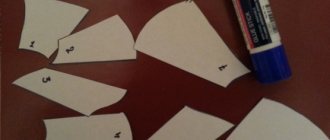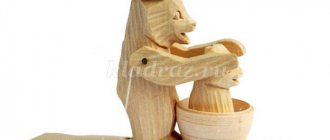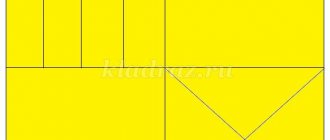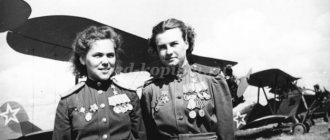ECD "Rainbow" for children of the preparatory group
Municipal autonomous preschool educational institution
“Child Development Center – Kindergarten No. 2”
Abstract of educational and research activities for children of the preparatory group on the topic “Rainbow”
.
Prepared by: Teacher of group No. 10
Abushaeva S.R.
Saransk, 2022
Goals:
• Introduce children to the atmospheric phenomenon of rainbows ,
reveal the reason for its appearance (reflection, refraction and decomposition of sunlight).
• Fix the colors of the spectrum and their sequence.
• Develop memory, attention, ability to work in a team.
• Create a desire to participate in experimental activities ,
cognitive activity.
Preliminary work:
• experimental activity on the topic “refraction and reflection of light”
,
“Colors of the spectrum, their sequence.”
• Vocabulary work: refraction, reflection, spectrum.
PROGRESS OF THE CLASS:
A cell phone rings in the group
- Guys, we received an audio message. Let's listen.
Hello guys! My name is Katya, I'm only 4 years old. I was told that in your kindergarten there are smart and sympathetic children, kind and resourceful teachers. Can I contact you with a request? Please tell us what " Rainbow " ,
where does it come from and why. Ask the teachers to make a video letter for me and send it to….
- Who saw the rainbow ?
When it was?
In dry, hot weather, during or after rain? Usually we see a rainbow when
the rain has not stopped yet, but the sun is shining in the sky.
To see a rainbow ,
you need to stand with your back to the sun.
- Shall we help Katya? Where do we start? First, let’s answer the question: “What is a rainbow ?” ( answers ) .
— Once upon a time, a person began to wonder why rainbows . People in those days could not explain this phenomenon, so they came up with myths and legends. Some superstitious people thought that this was a bridge to the other world, but scientists have found an answer to this phenomenon. So, a rainbow is a natural phenomenon that occurs when it rains and the sun shines.
The teacher invites the children to look at several pictures depicting a rainbow :
— The artist painted several rainbows .
Guess which picture shows
the rainbow that
he saw after the rain
(not a fairy-tale rainbow , but a natural phenomenon)
.
How is it different from your pictures? (sequence of colors)
.
How many colors does the rainbow ? The rainbow consists of seven colors, and they all follow strictly one after another, each “knows its place.” True, in nature there are no clear boundaries between colors; they smoothly transform into each other. There is a well-known expression that helps to remember the arrangement of colors in the rainbow :
Every Hunter Wants to Know Where the Pheasant Sits (the first letter of each word indicates a specific color: red, orange, yellow, green, blue, indigo, violet).
Integrated lesson with drawing elements for pupils of the senior group “Forest School”
Integrated lesson on the topic: “Forest school”.
Integration of educational areas of integrated classes in the senior group: Cognitive, speech, artistic and aesthetic, social and communicative, physical. Objectives: Educational area:
Strengthen the ability of ordinal and quantitative counting, the ability to count from a given number, comparison of sets, the ability to name adjacent numbers, knowledge of geometric shapes, orientation in space, laying out tangrams from geometric shapes, problem solving, develop logical thinking, memory.
Strengthen children's ability to differentiate objects by size, width, color. Developmental:
Develop children's coherent speech, continue to learn the sound analysis of words, divide words into syllables, the ability to form words from letters and read them, and compose sentences according to a pattern.
Educational:
Foster a culture of communication, activity in classes, and a desire to learn.
Equipment material
: envelopes with numbers, sentence diagrams, cards with geometric shapes, tangrams, files, paints, tracks of different lengths and widths.
Preliminary work
: ordinal counting from 1 to 10, counting backwards, working with geometric shapes, sound analysis of words, dividing words into syllables, composing sentences using diagrams.
Progress of the lesson
1. Introductory part. Greeting children. Educator: Guys, look how many guests we have today. Let's say hello to our guests, smile and give them our best wishes, which we will blow from our palms (goodness, love, health, happiness, peace, prosperity, good luck, prosperity, tenderness, beauty). Motivation. Surprise moment. Educator: Guys, we have a new ad hanging on our doors, let’s come up and look at it. Who do you think it's from? (illustration of an owl). Children: From an owl. Educator: That's right, guys, this announcement was sent to us by an owl. Let's read it. “Darlings, bunnies! I invite you to the forest school." Aunt Owl. Educator: Guys, who is this letter addressed to? Children: Bunnies. Educator: Who are we? Children: Guys. Educator: But the invitation is addressed to the bunnies, what should we do? Children's answers. Educator: And I suggest you turn into little bunnies. While I say the magic words, our guests will turn you into bunnies. Just need to hurry up. Ada-bra, Ka-da-bra, Sim-sa-la-mim. Guys, turn into little rabbits and find yourself in a forest school! And the forest school has opened its doors for you. Now you are bunnies, and I am Auntie Owl. And then the bell rings. The lesson begins. 2. Main part. 1. Conversation about bunnies. Come on, little bunnies, tell us about yourself. Where do you live? What do you eat? What can you do? How do you get around? What do you like? -Bunny Vladik, tell me where you live, do you have a house? (answer). -Bunny Nastya, what can you do? (answer). -Bunny Karina, what time of year do you like? Why? (answer). -Bunny Kiryusha, what do you like to eat? (answer). Owl: What other bunnies are there? Children's answers. Owl: And those bunnies that are sold in stores, what are they? Children: Toy. Owl: What is the difference between a toy bunny and a living one? Children: A toy bunny is made in a toy factory, and a live bunny is born to a mother bunny. Owl: What else are they different from? Children: Toy bunny: does not grow, does not breathe, does not eat, and does not reproduce. And a living bunny: grows, breathes, eats, reproduces, runs, jumps, changes its coat. Owl: How are bunnies similar? Children: Appearance. Owl: I also want to add that the toy bunny is made by human hands. Owl: We told you that there are live and toy bunnies. But there is also a mysterious bunny that appears when the sun is shining brightly and looks into our window. What kind of bunny is this? Children's answers (sunny bunny). What do you think, a sunny bunny might come to visit us today? Let's check. (Playing with a mirror) Did it turn out to be a bunny? Why do you think so?. Owl: Our lesson continues and the next task awaits us. Bunnies, let's play with the word, and which one you will find out if you read it 2. Working with the word. Collective work of children. (school). Owl: I turn over the letters, and you help name the sounds. That's right, SCHOOL. a) Sound analysis of the word. How many sounds are in the word school? Children: five sounds. Owl: Name the first sound. Children: sh - hard consonant. Owl: Name the second sound. Children: k-consonant is hard. Owl: Name the third sound. Children: o-vowel Owl: Name the fourth sound. Children: l - consonant. Owl: Name the fifth sound. Children: a-vowel. Owl: how many vowel sounds? Children: two sounds. Owl: how many consonants are there? Owl: which has more vowels or consonants? Determine how many syllables are in the word school by clapping. Children: two syllables. Owl: Let's play a game. 3. Didactic game “Guess the word” I will give the carrot to Nastyusha, and Nastyusha will name words that begin with the sound sh. -Karina name words that end with the sound a. 4. Practical exercise “Making a proposal.” Owl: Let's make a proposal according to the scheme. 1. How many words are there in a sentence? 2.Where is the word school? Think and make a proposal according to the diagram. (Little bunnies study at school) (Little bunnies study at a forest school). Owl: Well done, you completed the task. Now it's time for the bunnies to rest. The bell rings, change. Physical education lesson Jumping and jumping in the woods, Gray balls of hares. (Hands near the chest, like the paws of hares, jumping) Jump-jump, jump-jump The little bunny stood on a stump (Jumping forward backward) Lined everyone up in order Began to show exercises One! Everyone walks in place Two! Three are waving their hands together! They sat down and stood up in unison. Everyone scratched behind the ear. Four reached out. Five! Bend over and bend over Six! Everyone stood in a row again and walked like a squad. 5.FEMP a) Working with numbers and counting. Owl: And now the bell is ringing, all the bunnies are going to class. Didactic game “Offended numbers” (Individual work of children). Attention. First task A strange incident A rare incident has happened to us The numbers are in a quarrel And not a single one wants to stand with their neighbor We need to reconcile the numbers And restore their order. Owl: You have offended numbers in envelopes on your desks. You need to build a number series from 1 to 10. Lay it out from left to right. Now let’s check if all the numbers are reconciled and lined up in order. Now let's play the game "Guess the number." I will name the numbers, and you, taking the desired card with a number, show which number is one more (less) than the one named. What number is less than 7 by 1? What number is greater than 5 by 1? Name the neighbors of the number 2. What number comes after 9? b) Problem solving. Owl: Well done, you completed the task. Attention, the second task is called “Guessing Problems”. Four bunnies were walking from school and suddenly they were attacked by bees. Two bunnies barely escaped. How many didn’t make it? (2) Show your answer in numbers. 2. Once his neighbor came running to the bunny for lunch. The bunnies sat on a tree stump and ate three carrots. How many carrots were eaten? (6). How many hind legs do two bunnies have? (4). How many bellies do five hippos have? (5). How many houses do one hundred ants have? (1). Owl: Well done! We completed the task. Attention! Next task. b) Tangram “Portrait of a Hare” (work in pairs). Let's play with geometric shapes. Lay out your portrait according to the diagrams that are on your tables. You will post them in pairs. Owl: Well done! You got some beautiful portraits. d) The size of the objects “Forest paths”. Attention! Next task. "Forest paths." Bunnies are jumping in the forest along forest paths. The paths are different. Move the paths closer and look at them. How do they differ from each other? Children: By length, width and color. Attention! Lay out the paths from shortest to longest from left to right. -Which path is the shortest? (Children's answers) -Which path is the widest? (green) Owl: Well done! You did a good job. And now our fingers are tired, let's stretch them a little. Finger gymnastics “Bunny” Bunny, bunny, where is your tail? -clap Here, here, here! – hands behind your back Bunny, bunny, where is your nose? Claps Here, here, here! -show nose Bunny, bunny, where are the paws? - claps Here, here, here! - show paws Bunny, bunny, where are the ears? Here, here, here! - show ears. 6.Unconventional drawing “Carrot”. Owl: Bunnies, because you did all the tasks so well, I want to treat you to carrots, but there’s something wrong with them, they’re not visible at all, they’ve lost their color. Let's bring back the color with paint. What kind of paint do we need? Children's answers (orange and green) 7. Display of work. And we will draw on the file using a brush, using the poking method. We dip the brush into the paint and first draw along the outline of the carrot, and then paint over the entire carrot without going beyond the outline. Carefully remove the sheet from the file and turn the file over onto the sheet with the carrot. 8. Independent work of children. Owl: What beautiful carrots you made. Well done bunnies, you have returned the color to the carrots. 9. Final part. Owl: And now the bell is ringing, classes are over. The forest school is closing. Until next time. And it’s time for us to return to our own kindergarten. Come to our guests and they will help you turn into guys again. 10.Final conversation. Where have you been? What they were doing? Which tasks were difficult? What was easy? Did you like forest school?







